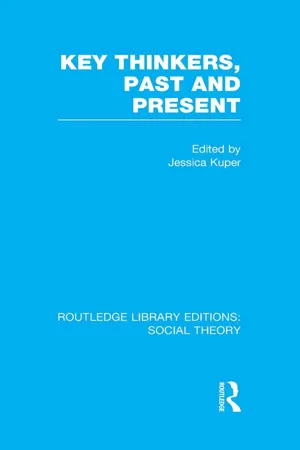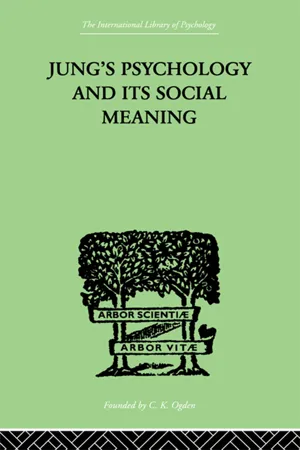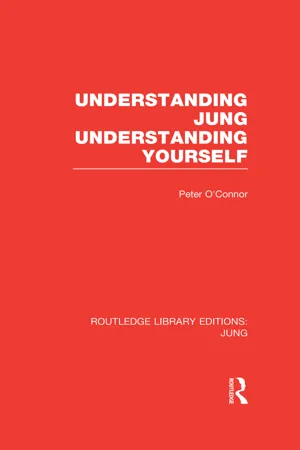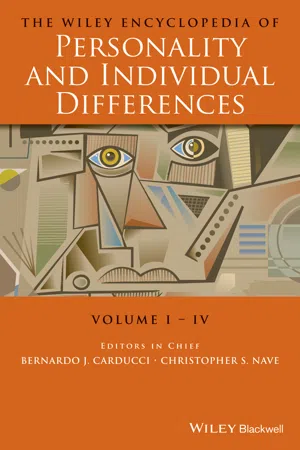Carl Jung
Carl Jung was a Swiss psychiatrist and psychoanalyst who founded analytical psychology. He developed the concepts of the collective unconscious, archetypes, and the process of individuation. Jung's work emphasized the importance of understanding the unconscious mind and integrating its contents for personal growth and psychological well-being.
7 Key excerpts on "Carl Jung"
- Jessica Kuper, Jessica Kuper(Authors)
- 2014(Publication Date)
- Routledge(Publisher)
...Jung, Carl Gustav (1875–1961) Carl Gustav Jung was a Swiss psychiatrist whose theories form the basis of Analytical or Jungian psychology. Concepts that Jung introduced to psychology include: the stages of life with age-related tasks, psychological types with differing attitudes (extraversion-introversion) and functions, the collective unconscious, archetypes, individuation or transformation as an aim of analysis, feminine and masculine principles, and synchronicity (meaningful coincidence). Jung’s depth psychology considers spirituality important. It is considered especially suitable for people in the second half of life, who may be well adapted but plagued by a sense of the meaninglessness of life. His psychology is also of particular value in working with psychosis, since his insights into symbolic material help make delusions and hallucinations, as well as dreams, intelligible. Jung was a prolific writer; his Collected Works (1953–79) contains eighteen volumes. His theories have also had a major impact on literature, history and anthropology. Training centres in Jungian analysis exist in Europe and the United States. Certified analysts are members of local or regional Societies of Jungian Analysts and the International Association for Analytical Psychology. Jung’s life and his theories are intertwined, as he emphasized in his autobiography, Memories, Dreams, Reflections, (1961): ‘My life is a story of self-realization of the unconscious. Everything in the unconscious seeks outward manifestation, and the personality too desires to evolve out of its unconscious conditions and to experience itself as a whole.’ Jung was born in 1875 in Kesswil, Switzerland. A sensitive child who played alone in his early years, he mulled over questions raised by his dreams and by observations of himself and others. As a student, he was powerfully drawn to science, especially zoology, paleontology, and geology...
- eBook - ePub
- Leanne Whitney(Author)
- 2017(Publication Date)
- Routledge(Publisher)
...By his own account, his work can be described as a general psychology that takes notice of the empirical material of pathology (Jung, 1973). In short, Jung’s psychology is concerned with the alleviation of human suffering by means of confrontation, interpretation, and adaptation between conscious and unconscious processes. This psychological approach, Jung termed the process of individuation. Succinctly, individuation aims at the reconciliation of opposites to experience wholeness. In addition to the aforementioned pioneers of the unconscious, Jung’s other influences were broad. For example, German Naturphilosophie, art, religion, world mythology, parapsychology, Eastern philosophy, and quantum physics all factored into his thinking and theories. Highly influential European philosophers on Jung’s body of work included Nietzsche, Kant, and Schopenhauer. Major collaborators included German sinologist and theologian Richard Wilhelm, Swiss researcher and alchemy scholar Marie-Louise von Franz, and the Austrian Nobel Prize–winning theoretical physicist Wolfgang Pauli. Although Jung’s autobiography and enormous body of work do not mention his relationships to patients Sabina Spielrein and Toni Wolff, it is believed both women significantly influenced his psychological ideas. No doubt his wife Emma’s role is also significant, although interestingly, and glaringly, underplayed. Jung is credited as one of the first Westerners to note the importance of the East–West dialogue and to actively pursue it. Although Jung’s interpretation of Eastern ideas is not always perceived as accurate (Clarke, 1994; Coward, 1985; Meckel & Moore, 1992), Jung’s interest in Eastern thought presaged the post-colonial Easternization of the West (Shamdasani, 2003). Furthermore, the translation and widespread circulation of yoga texts historically paralleled the birth of depth psychology (Shamdasani, 1996). Jung was exposed to Hindu culture prior to his professional life...
- eBook - ePub
Psychology for Actors
Theories and Practices for the Acting Process
- Kevin Page(Author)
- 2018(Publication Date)
- Routledge(Publisher)
...Below is a very select list of Jung’s contributions to psychology, many of which began with Freud’s ideas and then surpassed (or directly contradicted) them. For a more complete understanding of Jung’s innovative conceptions, I recommend reading Jung’s original material, as cited in the references at the end of this chapter. Two Realms of the Unconscious Jung came to believe that there were two vast areas of the human unconscious, the personal and the collective. In Jung’s model, the personal unconscious contains repressed material, such as painful memories, as well as unimportant or forgotten memories not retained in conscious awareness. The personal unconscious might also include aspects of the personality that had never before become conscious. So, Jung’s personal unconscious looks a lot like Freud’s unconscious. But then Jung added an entire other realm that included collective and “transpersonal” contents that were shared by all people, much like how we think of the instinctual drives of animals. The collective unconscious contains material that is not directly derived from an individual’s personal life experience, but are universal patterns and images that have evolved over the whole of human existence. The collective realm also contains images and patterns from prehuman evolutionary development and instincts inherited from animals. These prototypical images and forms, representing the most common experiences shared by the human species, Jung called the “archetypes” (Jung, 1968, pp. 42–43). Each archetype represents a basic psychic disposition or potential (Frick, 1991, p. 38). From the evolutionary dawn of the human race, for instance, people have shared the general experience of mother, father, birth, death, god, power, magic, the “hero” figure, the “stranger” or “outsider,” and clan prejudice or ethnocentrism...
- Amy E. Wenzel(Author)
- 2017(Publication Date)
- SAGE Publications, Inc(Publisher)
...The analyst encouraged the analysand to engage these contents from a strong ego position, using the active imagination and recording one’s personal responses, which took a variety of expressions. In doing so, the personality of the analysand developed toward maturity, as it integrated these complementary opposites that resided within. The transcendent function of the analysand’s psyche enabled a uniting, third conscious position to emerge, which synthesized the conflicts and united the opposites into a new attitude and into a transformed personality that was more complete or whole. The Psychoanalytic Approach Jung and the first Jungian analysts differentiated themselves from the psychoanalytic approach of Sigmund Freud and other pioneers. Jungian analysts focused on the collective unconscious with attention to mental contents that were both unique to the individual and shared by humanity across places and time. Everything about the human psyche and its manifestations interested them. In contrast to the prevailing zeitgeist of the time, they attended to some therapeutic topics that were ignored by the current scientific paradigm, such as spirituality/religion, and did not focus only on the psychological topics that were conventional or could be reduced to elements amenable to study by the available scientific methods. For example, Jung used the Greek word for “soul,” psyche, for the mind, to grasp the richness and basic difficulty of analyzing scientifically the human spirit/mind/body connection. Thus, Jung conceived of psychology as a field that addressed issues that needed to serve larger human purposes and values. Jungian psychoanalysis, as Jung speculated, was a way of recovering a balance of the opposites that threatened to split the mind from its moorings in an overrationalistic context, which could cut persons loose from their instinctual and emotional base...
- eBook - ePub
Jung's Psychology and its Social Meaning
An introductory statement of C G Jung's psychological theories and a first interpretation of their significance for the social sciences
- Ira Progoff(Author)
- 2013(Publication Date)
- Routledge(Publisher)
...On the other levels, the myth is understood as being within the group and also latently within the individuals in a way that goes through time. The questions of how specific traits of individuality are related to the historical form of the myth, and how, conversely, myths express themselves in the products of culture, require clearer analysis, but we can see the value of the concepts. The question of the archetypes and individuality is in one sense a paradox, and in another sense it is an anthropological statement of the eternal philosophical problem of the universal and the particular. In interpreting the archetype concept, it is most important to regard it as essentially a tool of thought, a mode of formulating and organizing an exceedingly difficult and elusive subject matter. Its great value is as a focus for study in developing hypotheses regarding the creative and spontaneous manifestations of the psyche. Certainly, the worst mistake that can be made in interpreting Jung is to treat his work as though it were a final product rather than a brave expedition into a new realm of science. The value of his leading concepts—the archetypes, the collective unconscious, the historical conception of the psyche—lies mainly in the orientation they give to the study of man. They carry with them not so much a body of knowledge as an attitude toward the reality of the psychic life and the validity of the spiritual experiences of man in history. The depth conception of the psyche, focused as Jung's is toward social rather than toward biological questions, contains a perspective that is radically different from the current academic views. Its unorthodoxy is one of its great values if only for the stimulation of thought that it can bring to the social sciences. In its present state, however, the Jungian point of view still has left much undone...
- eBook - ePub
- Peter O'Connor(Author)
- 2014(Publication Date)
- Routledge(Publisher)
...It is its very occupation with the inner subjective world as opposed to the objective outer world that means the psychology depends very much on the psyche of the psychologist. In other words, as Jung himself said, the closer psychology reflects its subject-matter, the psyche, the more it merges with the psychologist himself. In so doing, it becomes like music or painting, an art form and always a subjective state. Nowhere is this merging of psychology and psychologist more clearly seen than in the person of Carl Gustav Jung. In fact, his immense theoretical edifice can in the most basic of terms be seen as an attempt to reconcile and integrate the subjective and objective within himself. It seems to me ludicrous, particularly in this area of inner subjective-orientated or dynamic psychology, to separate the ideas out from the personality of the man to whom the ideas occurred. Hence the bulk of this first chapter will be concerned with Jung’s personal background, followed by an attempt to distil from this the personal images and myths that may have been moving Carl Gustav Jung and propelling him to make sense of this inner experience. Finally, I will attempt to give a brief synopsis of the Jungian perspective that emerged from this complex fabric of Jung’s personal life. Personal Background Carl Gustav Jung was born on 26 July 1875 in the small Swiss village of Kesswil on Lake Constance. He was the only surviving son of a Swiss Reformed Church pastor. Two brothers died in infancy, before Jung was born, and his only sister was born nine years later. His father, from Jung’s own account in his autobiography, Memories, Dreams and Reflections, was kind, tolerant and liberal. However, he was also somewhat conventional and seemingly content to accept the religious belief systems in which he had been reared; unable, it seems, to answer the doubts and queries of his very gifted son...
- (Author)
- 2020(Publication Date)
- Wiley(Publisher)
...This stunned Jung, as he had come to Freud with a world‐class reputation, rather than as an intellectual neophyte. When the International Psychoanalytic Association was formed in 1910, Jung became its first president at the request of Freud. Jung was being groomed to be Freud's heir to the psychoanalytic movement. However, growing theoretical differences, especially over the importance of sexual energy, resulted in Jung’s resignation from the group only four years later. The split was bitter and clean. The two men never met or spoke to each other again. From 1913 to 1917, while experiencing some serious emotional difficulties in his own life and even contemplating suicide, Jung engaged in a monumental effort of self‐analysis. The outcome of this self‐analysis produced some of Jung's most original theoretical concepts. After this self‐analysis and the recovery from his emotional disturbances, Jung continued his work for over 60 years, establishing himself as one of the most noted psychological thinkers of the twentieth century. For example, Jung studied schizophrenic patients in Switzerland, Navajo Indians in America, native tribes in Africa, and African American patients in Washington, DC. He participated in archeological and anthropological expeditions to explore diverse cultures in Egypt, the Sudan, and India, all into an attempt to verify his theory of personality. He was extremely well read in theology, anthropology, archeology, psychology, ancient texts, the occult, and mythology, as well as psychiatry. He incorporated this diverse knowledge into his theory of personality. Jung died on June 6, 1961 in Zurich at the age of 85. He was an active and productive researcher and writer his entire life. Structure of the Mind Jung’s view of the structural nature of personality clearly reflected a redefined, expanded view of the unconscious mind (Campbell, 2008 ; Jung, 1934/1960). The conscious ego is the center of conscious awareness of the self (Douglas, 2008)...






